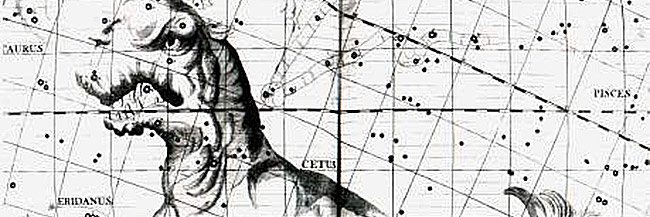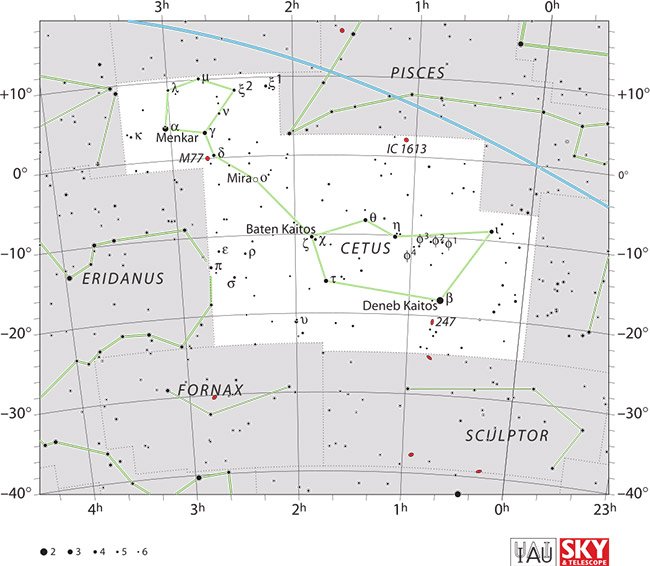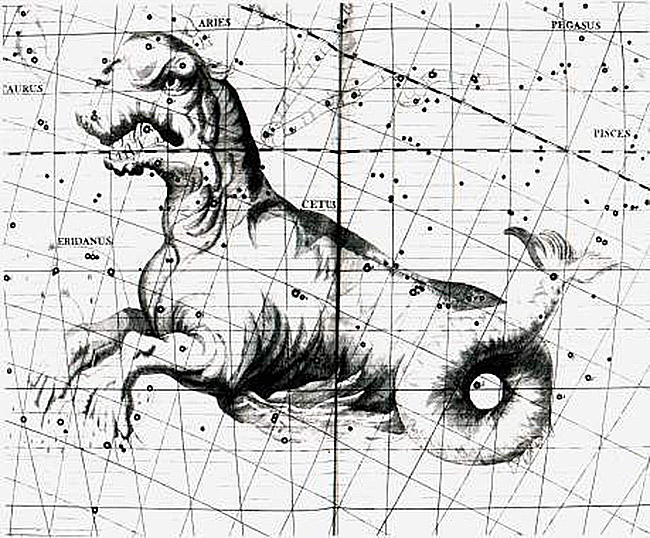Cetus – Constellation Facts
 Alessio Govi, Public domain, via Wikimedia Commons
Alessio Govi, Public domain, via Wikimedia Commons
Cetus is the sea monster in Greek mythology that had Andromeda left as a sacrifice for her mother’s vanity. It lies in the first quadrant of the Southern hemisphere and is located specifically between latitudes of +70° and -90°. Along with other constellations, Cetus was first catalogued in the 2nd century by, Ptolemy, a Greek astronomer.
Constellation Characteristics
Cetus is the fourth largest constellation in the night sky, occupying 1,231 square degrees. Cetus is also neighbors with Aquarius, Aries, Eridanus, Fornax, Pisces, Sculptor and Taurus. In addition, this constellation has four main stars and nine deep space objects, including one Messier and three meteor showers.

IAU and Sky & Telescope magazine (Roger Sinnott & Rick Fienberg), CC BY 3.0, via Wikimedia Commons
By IAU and Sky & Telescope magazine (Roger Sinnott & Rick Fienberg) CC BY 3.0, via Wikimedia CommonsPlanetary Systems
Cetus has nine deep sky objects. Read on to discover some fascinating facts about these celestial wonders.
- Messier 77 (M77, NGC 1068): this celestial wonder is one of the most massive listed (170,000 light-years in diameter) and is a barred spiral galaxy. This galaxy has an AGN or an Active Galaxy Nucleus; however, it is blocked by interstellar dust particles.
- NGC 1055: seen on its edge, this spiral galaxy has a diameter of around 115,800 light-years and is also a known radio source.
- NGC 1087: is listed as an intermediate spiral galaxy that has a very small nucleus and a small central bar. It is located approximately 80 million light-years away.
- NGC 1073: this galaxy has an H II nucleus and an apparent magnitude of 11.5.
- NGC 45: discovered in 1835, this barred spiral galaxy is located 32.6 million light-years away.
- NGC 17: believed to be the result of two disk galaxies merging, NGC 17 is located 250 million light-years away and is catalogued as a spiral galaxy.
- NGC 47 (NGC 58): situated 236 million light-years away, this barred spiral galaxy appears as a small spiral nebula with a bright core.
- NGC 1042: this spiral galaxy is associated with NGC 1035 because of their close proximity and they are alike in redshifts.
- NGC 247: also known as Caldwell 62, this intermediate spiral galaxy is estimated to be around 11.1 million light-years away.
Main Stars
The constellation Cetus contains four main stars that makes up its shape. Let’s explore them further.
- Deneb Kaitos (Diphda) ~ (Beta Ceti) shines the brightest in the Cetus constellation (which will be discussed later in detail).
- Menkar (Menkab) ~ (Alpha Ceti) is a very old red giant on its way to being a white dwarf; it does this by ejecting its outer layers to form a planetary nebula. Its Arabic name means “nostril.”
- Mira (Omicron Ceti) is a binary star that belongs to a class of oscillating variable stars; there are 6,000 to 7,000 of these stars in this group. It is believed to be around 6 billion years-old and its name means “wonderful” in Latin.
- Tau Ceti is one of the nearest stars to our solar system (11.9 light-years away) and is a cool class G dwarf. It is less massive than the sun and is also visible to the naked eye.

Alessio Govi, Public domain, via Wikimedia Commons
The bizarre-looking sea monster Cetus emerging from the ocean of the southern skies, illustrated in the Atlas Coelestis of John Flamsteed (1729).Most Shining Star
Out of all the stars that make up the Cetus constellation, none shine brighter than Deneb Kaitos (Diphda) ~ (Beta Ceti). This star is evolving from an orange giant into a red giant, with a surface temperature of 4,800 Kelvins; making it a bit less than our Sun. Its name, Deneb Kaitos and Diphda Deneb Kaitos comes from the Arabic phrase meaning “the Southern tail of Cetus” (Al Dhanab al Ḳaiṭos al Janūbīyy).
Mythology & History
As Greek mythology tells the tale, Cetus was the sea monster that was to devour Andromeda for her mother’s vanity. However, even though Cetus is depicted as a whale, the Greek mythology portrays this beast as a hybrid of sorts. It had a scaly body like a sea serpent, huge jaws and feet on the front of its body.
In the myth, Cetus was to ravage the king and queen’s land unless their daughter (Andromeda) was left as a sacrifice for Queen Cassiopeia’s boastfulness. But before Cetus could take Andromeda, Perseus rescued her and they were later married.
Cetus is a fascinating constellation, so the next time you are gazing into the night sky, be sure to search out this intriguing figuration of stars.
